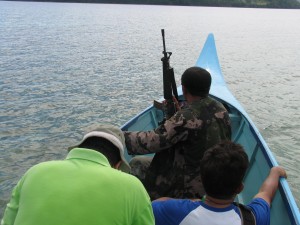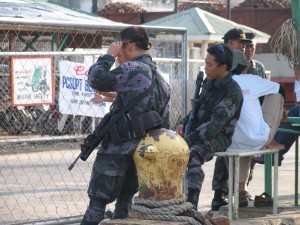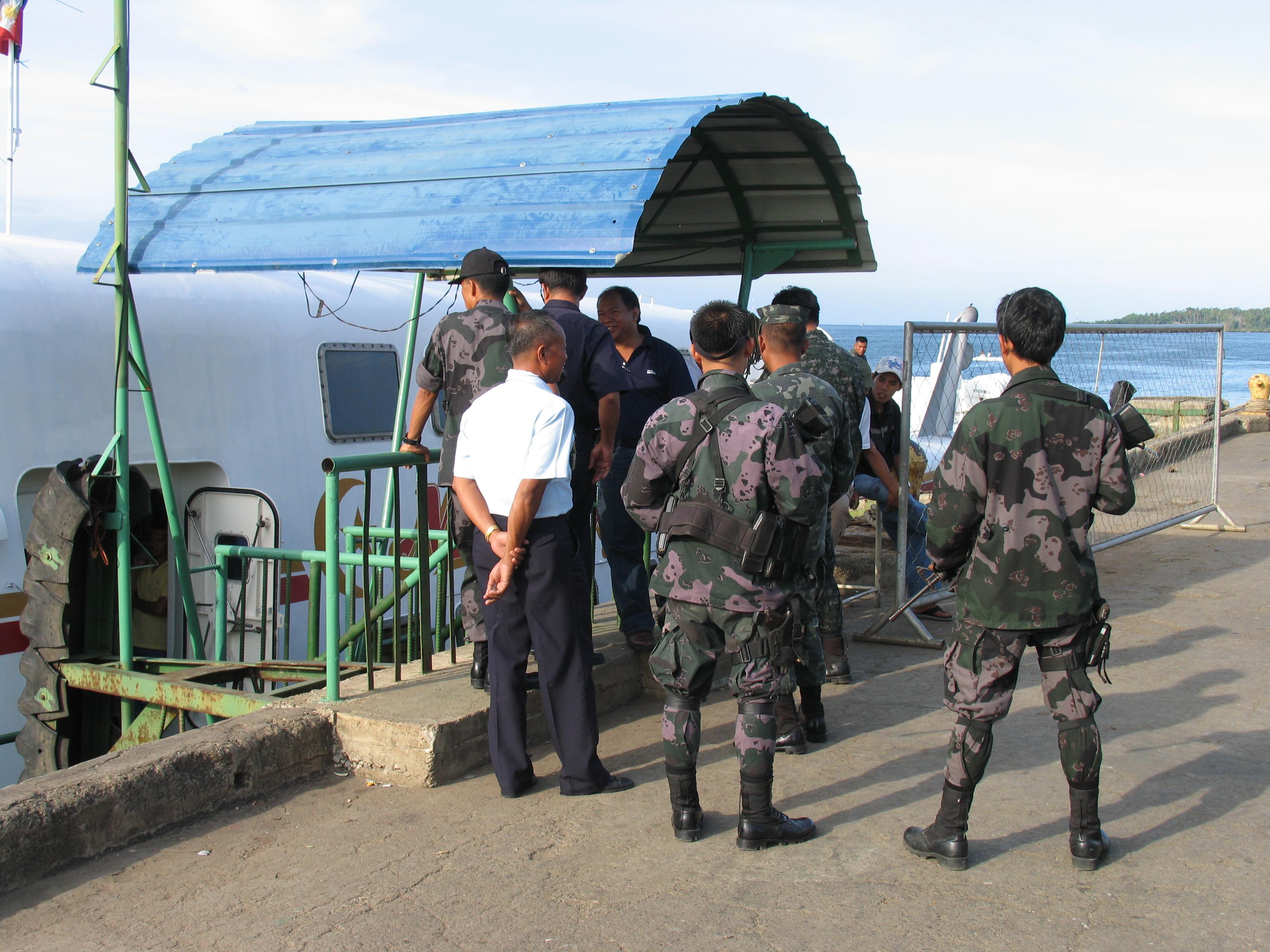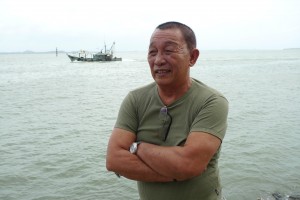The Moro National Liberation Front (MNLF) is a nationalist political organization that has been waging an armed struggle against the Philippine state since its establishment in 1969.
It struggles for the independence of Bangsamoro. As defined by the MNLF, the territory of Bangsamoro covers Sulu, Mindanao, and Palawan—otherwise known as MINSUPALA, encompassing some of the poorest areas of the Philippines.
Unlike its Islamic offshoot, the Moro Islamic Liberation Front (MILF), MNLF is not a religious organization, and it styles its ideology as Egalitarianism. A racially and religiously inclusive organization, MNLF calls for independence and social justice for the most exploited and marginalized people of the Philippines—a country where according to a 2011 survey, some 20.5 percent of families, or about 4.1 million, go hungry while 51 percent, or some 10.4 million families, consider themselves poor.
MNLF Central Committee member Commander Haji Ibrahim “Bambi,” 67 years old, met the author for an interview in January 2013 at an undisclosed location in Sabah, Malaysia.
AV (Andre Vltchek): Peace process, peace agreements, broken peace agreements, and more process—it appears a never-ending saga. You are facing the Armed Forces of the Philippines (AFP), one of the most brutal and corrupt armies in the world, which is determinedly supported by the former colonizers of the Philippines, the United States, Spain, and indeed Europe. Do you have any chance to win the war and consequently the independence for your people?
CB (Commander “Bambi”): It would not be easy. We would all have to unite: MNLF, MILF, and the Marxist groups. MILF would have to agree to join the constitutional process and agree to negotiate, something they are refusing to do. We all have to sit down and talk.
The United States, Europe, and the entire West would then have to join our effort to implement, and then support, a real peace agreement.
The peace process is in danger, because most of the terms agreed on during the Tripoli Agreement of 1976 and later at Jeddah Accord in 1987 were never implemented. The government is now busy dealing with the MILF. On top of it, the peace process would have to go through the constitutional procedure, within the government of the Philippines. It would have to go through the Senate and through the Congress. And the fact that there are more Christians than Muslims in both institutions, even in the Mindanao local Senate, would further complicate things.
Once I attended a meeting sponsored by one of the EU countries. There were also representatives of Colombia there, of Indonesia, as well as three people from the U.S., probably CIA. I told them, “American brothers, you are not our enemies, are you? You were preaching to us about freedom for so many years and decades. But when you are here, you are not seeking peace, instead you are siding with the Philippines government against the will of the people.”
AV: What exactly is the United States trying to achieve by supporting the Philippine regime?
CB: The U.S. goal is to control the entire Pacific. It wants to prevent China from playing any significant role in this part of the world.
The U.S. is playing a very dangerous game by training the Philippine military, justifying it by the “search” for Abu Sayyaf fighters. All this is against the Philippine Constitution—the U.S. military is not allowed to operate on the territory of the Philippines. But conducting joined exercises like “Balikatan” is supposed to give “legitimacy” to illegal military acts.
Rebels sailing to a conflict zone (photo by Andre Vltchek).
AV: What are you called by the U.S.?
CB: In the past, they used to call us Maoists or Communists.
We are not on that terrorist list of theirs. But they consider us their main enemies.
Abu Sayyaf is on their terrorist list, of course. But the CIA created Abu Sayyaf during the government of Ramos, to undermine the MNLF. Both the U.S. and Philippine governments needed more bombs to explode, more weapons to be used, in order to have their military budgets approved. It is also no secret that during the wave of kidnappings by Abu Sayyaf, 80-90 percent of the ransom money used to go directly to the military leaders.
The government and the U.S. say to the MNLF: “Oh, you can’t control your own people—look at Abu Sayyaf!” They say no peace can be reached if we can’t control Abu Sayyaf. It is undeniable that some Abu Sayyaf fighters are former members of MNLF, including Commander Nur.
But what they refuse to say and acknowledge is that we hate Abu Sayyaf! We have nothing to do with them. All over Mindanao, people are distancing themselves from them, seeing them as clients of the U.S. forces. Abu Sayyaf has such a bad image!
The MNLF even fought Abu Sayyaf. Once they kidnapped a female medic from our ranks. We attacked their camp and freed the medic.
AV: Is the U.S. using propaganda to justify its presence in the Philippines?
CB: Yes, the propaganda is used all over the Philippines. The U.S. is always portrayed as liberators, as good guys. People are flooded with movies, books, and shows… Douglas MacArthur is presented as liberator, and people actually believe it, after all those years and decades of propaganda.
And then the story of liberating us from the Japanese! Of course old people in the Philippines were not used to the character of the Japanese, when they occupied the country—like bowing. There were cultural misunderstandings, and even crimes committed by the Japanese. But Japanese invaders never performed mass slaughter of the Philippine civilians, while the U.S. did. What is guarded as some secret is that the U.S. was much more brutal than Japan in this part of the world, and that brutality was occurring even before the Japanese occupation. Just recall the Balangiga massacre.
AV: I heard, from Philippine academics, that the U.S. is igniting the conflict between several regional players in Southeast Asia and China over the Spratly Islands. It apparently found exceptionally willing collaborators in the latest Philippine administration.
CB: Once again: the U.S. wants to have full control over the Pacific. For that it needs countries like the Philippines—client states.
We provoked the problem of the Spratly islands. Our government dares to play this game because it knows that it has U.S. behind it.
It is worth mentioning that the Spratlys were historically part of the Sulu Sultanate. The islands are called, in the local language, “Manangkayan,” or “Giant Clam.” Sulu sultans were extremely close to China. There are graveyards of Chinese people all over Sulu. Chinese emissaries were living right next to the sultan’s palace. China was the closest ally of Sulu before the Spanish conquerors arrived. What followed, you know: things were turned upside down and the Spaniards massacred around 10,000 Chinese people in one go, just because they did not want to abandon their culture, to change their name.
But in the Philippines, very little is known about the history of the region.
Why provoke China? The government is spending so much money on modernizing warships. For what purpose? Is it to go to war with China on someone else’s behalf? Why not improve Philippines instead? There is so much misery there.
Philippine soldiers (photo by Andre Vltchek).
AV: You were one of the leaders of MNLF for so many years and decades. Did things change? Is the MNLF aiming at autonomy now?
CB: First we called for independence. Then Islamic countries pressed us. They told us try autonomy first and go from there.
Ideally, we wanted independence of all Mindanao. We felt that this is an essential goal as we were kept behind by Manila—absolutely behind. I personally would have settled in the past for Mindanao being first just one state inside the country, similar to the arrangement they have here in Malaysia. You give the capital 20 to 30 percent of the natural resources, etc. But after achieving such an arrangement, I would still be pushing for full independence.
AV: Would it be a Muslim or a secular state?
CB: It would be, and would have to be, a secular state. There are now more Christians in Mindanao than Muslims. It would be a state for all of us: for Christians, Muslims, and Buddhists, and for Chinese people. In our ranks, we have Christians, and many Chinese support us.
AV: What political and economic system do you envision for it?
CB: A mixed system. Definitely not a purely capitalist system—look at the Philippines; we don’t want that. I wish for open socialism.
AV: What about the Marxists? Would you cooperate with the Marxist guerillas in Mindanao?
CB: Of course! Around 1976, I met and incorporated some of their fighters. More precisely, we joined forces. At that time I was in command of some 70 men and their group in that particular area had only 7 or 8 people. We always see them as our allies. Those who are fighting against the Philippine government, that brutal and corrupt power, are our allies.
AV: When you say “brutal and corrupt power,” do you have in mind the Maguindanao massacre?
CB: Exactly. That was one of the most terrible examples of how corrupt and brutal the power in the Philippines is. It was a terrible story of the Ampatuan clan trying to demonstrate to President Arroyo just what it could do in its own province. And the message was: we can do anything! Because, although the West calls the Philippines a “democracy,” the rulers can do anything they feel like to their own people. In Maguindanao, people who went against the Ampatuan clan got massacred; women, including journalists, were raped before being murdered. The women were shot in their genitals and then decapitated. Fifty-seven people, including 34 journalists, died. Once you go against the rulers, this is what happens to you in the Philippines.
AV: I was once working in Gingook and Cagayan de Oro, in Mindanao. I was invited by one of the mightiest ruling clans in the country, because I was a friend of one of the greatest Philippine musicians, who happens to belong to it. At a dinner party, members of the clan began discussing the upcoming elections: whom they are going to pay, whom they are going to bribe, and how much money will be involved. They knew who I was; some even read my books before they invited me. But they had no fear. They were certain that nothing could endanger their power and their plans. They were even naming names of their allies in the government at the table, in front of me.
CB: You are right: they have absolutely no fear! They buy votes, openly. Everybody knows how much is paid and by whom. It is utter madness.
A Philippine military patrol (photo by Andre Vltchek).
AV: How many people in Mindanao support the MNLF?
CB: 99 percent of the Muslims. Now we are in the process of explaining to our Christian brothers that ours is not a Muslim cause, and that not all the Muslims are bad.
AV: How bad is anti-Muslim propaganda and discrimination in the Philippines?
CB: Bad, very bad. And it has been spread for centuries.
What they don’t say is that before the Spaniards came to colonize us, all these were actually Muslim lands, even what is now Manila. Then they began destroying our culture, attacking our religion. They forced us to become Pablo or Pedro, instead of Ibrahim or Abdullah. In the past, Spanish people called us “pirates.” But who are really the pirates here? Aren’t pirates those who invade your country and then plunder it?
Under Marcos, Christian militias called Ilaga began chasing away Muslim people from their homes in Mindanao.
There were also large resettlement schemes and many land grabs of Muslim lands, designed to make Muslims a minority in their own areas.
AV: How many people have died in the war so far?
CB: We don’t have exact numbers, but even a long time ago we calculated that well over 100,000 civilians must have died. Often we had no time to bury our dead—they were sometimes eaten by dogs. It was terrible. So just in the 70s, over 100,000 people died.
In Zamboanga Norte in 1976, I could only count human heads—68 heads in all—because the government forces had burned the bodies. All of the victims were highlanders from the Kalibugan tribe. Some skulls were big, those of adult men and women, but some were tiny—those of the babies. And this was just one massacre of so, so many!
Marcos introduced martial law during his administration. We lost more fighters during that period, but the government of Philippines had three times heavier losses than we did.
AV: So what is it going to be now—a war or negotiations?
CB: We have to join forces—all of us who are fighting for independence and justice. But we have already fought so much! We fought during Marcos; once I fought for 6 months, day and night, without any rest.
I am tired. I am tired of fighting. I am 67 years old. I know that this war could go on and on, for another 100 years.
I know the culture of the people in this part of the world. What frightens me is that one day some religious fanatics could influence our young boys. It can happen, you know, if there is no solution to the conflict. It would be extremely dangerous scenario.
AV: At 67, are you still actively involved in the struggle?
CB: Yes, I am still a member of the Central Committee and Commander of the Special Forces of MNLF.
But I am now actively looking for peaceful solutions. The peace agreements we had are not solid. I want all the opposition to join, to unite, to negotiate.


